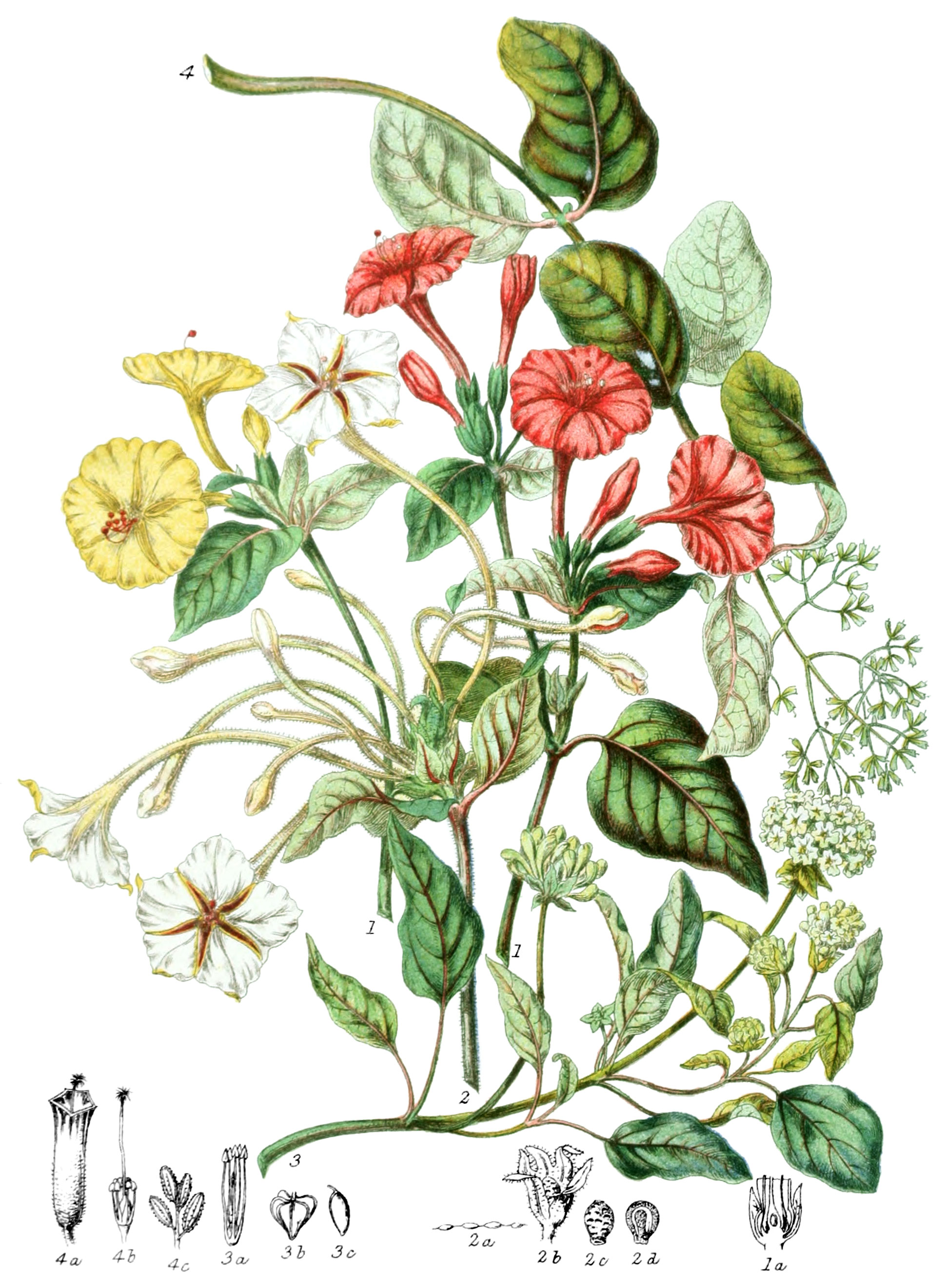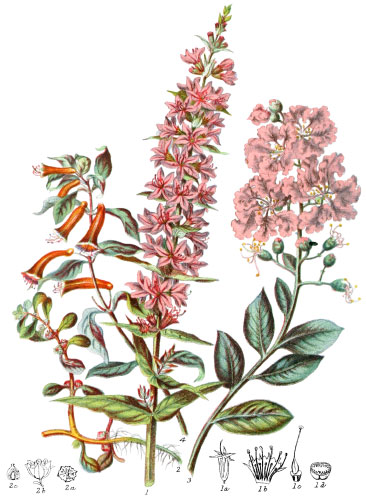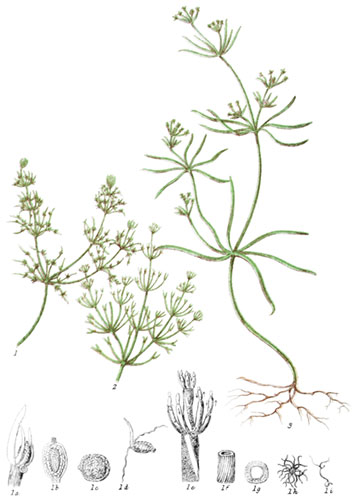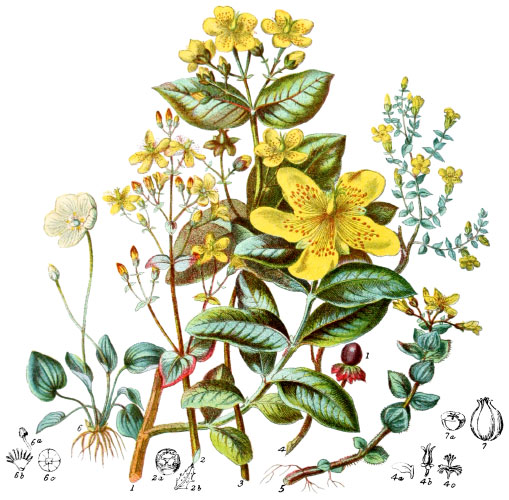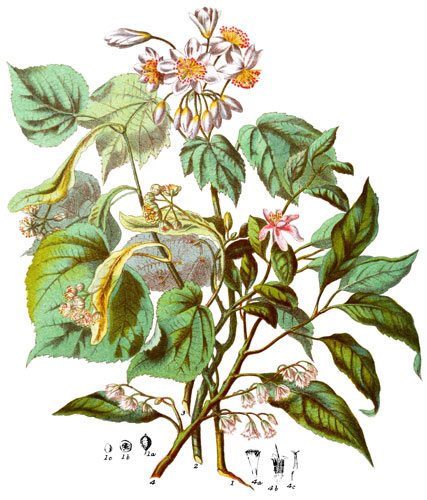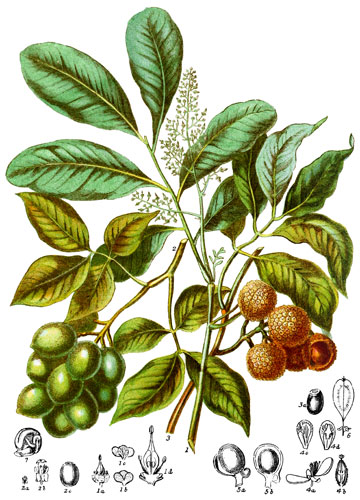Key characteristics
Cheifly herbaceous plants, both annual and perennial, a few shrubs and trees. The leaves are usually opposite, sometimes alternate, almost always unequal, without stipules. The flowers grow on terminal stalks, or from the base of leaf-stalks, in clusters or solitary, sometimes imperfect, having and involucre of one or several parts, either minute or large, often brightly coloured. The calyx is tubular, coloured, the limb whole or toothed, plaited in the bud, becoming hardened at the base, forming a covering to the seed, the limb falling off. The stamens are of definite number, attached to the base of the ovary, sometimes on the side. The anthers are two-celled. The ovary is above the calyx, with a single erect ovule; the style single, the stigma simple. The fruit is thin, enclosed within the persistent base of the calyx; the seed is destitute of the usual covering, the base of the calyx cohering to it; it contains farinaceous albumen.
This Tribe has close affinity with Amarantaceæ and Chenopodiaceæ, but is distinguished from both by the base of the calyx becoming a tough covering to the seed.
Select plants in this order
Not all plants listed are illustrated and not all plants illustrated are listed.
- Mirabilis is the usual Latin appellation of the genus which is the type of this Tribe, but French botanists still prefer the name Nyctago, given it by Van Royen, and adopted as the designation of the plants generally, in allucation to their night-blowing. Clusius named it Admirabilis.
- Mirabilis Jalapa (1) is the most frequent example of the genus in our gardens, having been introduced before the close of the 16th century; the large tuberousu roots were formerly supposed to yield the true medicinal Jalap, but that opinion has been long since found to be erroneous. The flowers by cultivation acquire varied colours, which renders it a pleasing ornament to the border.
- M. longiflora (2) was not brought to England till 1759, and is a less hardy species, not flourishing in all soils, but is very desirable annual plant, from the extreme fragrance of its delicate flowers, which expand about sunset and wither before sunrise, so fragile is their texture. The long tube is clothed with glutinous hairs by which small insects are detained; the roots are powerfully medicinal.
- M. dichotoma of the West Indies opens its flowers in the afternoon, and is called by the French fleur dequatre heures.
- M. suavolens is a medicinal plant much employed in Mexico as a cure for rheumatism; the scent that resembles that of Anise.
- Although many species of Mirabilis are admired for their beautiful and fragrant flowers, others are of very insignificant aspect and rank amongst mere weeds. The seeds of some contain so large a portion of farinaceous albumen, as to afford a supply of food to the Japanese: they have also the art of extracting a colouring pigment from them.
- Abronia is a genus of no known use, yet with delicate pretty flowers.
- A. mellifera (3) is found in the northern parts of California in 46° of north Latitude, and 12° of west longitude; it was first discovered by David Douglass near the Great Falls of Columbia, and is abundant on the dry, sandy deserts of the interior of the country, never seen on the sea-shore, where grow A. umbellata and A. arenaria. The stem and flower-stalks are slightly glutinous, like those of several species of Mirabilis; the flowers have the scent of honey in the evening, which is the usual time of perfection for these plants. The involucre of A. umbellata is of a bright pink colour, which gives a singluar effect to the flowers.
- Pisonia is a genus of evergreen shrubs named after Piso of Amsterdam, who wrote on the Natural History of Brazil, 1648.
- P. obtusa (4) offers a striking contrast to the herbaceous plants of this Tribe, being perennial in its nature, of stiff foliage and minute inflorescence of no beauty of colour. The seed is covered with a soft pulpy substance that is considered eatable in its native country. The roots contain medicinal properties.
- P. aculeata belongs to the East and West Indies, is very common in Jamaica and St. Domingo. The spines are awl-shaped, with a recurved sharp point, they grow at the base of the leaf-stalk, perpendicular to the branch, and cause much inconvenience to travellrs, sometimes nearly preventing their passage through woods, by arresting their garments. The fruit, covered with small glutinous points, clings fast to everything that comes near to it, and frequently encumbers birds on their flight by sticking to their wings.
- P. inermis is a native of the Island of Carthagena.
- Boerhaavia was so called in honour of the famous botanist of Leyden, who died 1758, the first friend and patron of Linnæus.
- B. hirsuta and B. procumbens have both medicinal properties.
- The root of B. decumbens is called hogmeat in Jamaica, and is used as an emetic in Guiana like Ipecacuanha.
- B. diffusa and B. repanda grow almost everywhere in India.
- B. viscosa is a climbing plant of Peru; B. scandens of Jamaica.
- Bugainvillea, recording the name of a celebrated traveler, is also of a climbing habit, with large rose-coloured bracts in the conical clusters of flowers.
Locations
This Tribe exists chiefly in the Tropics, scarecely extending far beyond them, except Abronia in North America, and Boerhaavia in the Southern Hemisphere.
Legend
- Mirabilis Jalapa, Marvel of Peru. West Indies.
- Section of Flower.
- Mirabilis longiflora, Fragrant Marvel of Peru. Mexico.
- Hair, magnified.
- Involucre and Seed.
- Seed.
- Section.
- Abronia mellifera, Honey-scented Abronia. California.
- Stamens and Pistil.
- Fruit.
- Seed.
- Pisonia obtusata, Obtuse-leaved Pisonia. South America.
- Flower, magnified.
- Stamens and Pistil.
- Cluster of Fruit.
Explore more
Posters
Decorate your walls with colorful detailed posters based on Elizabeth Twining’s beautiful two-volume set from 1868.
Puzzles
Challenge yourself or someone else to assemble a puzzle of all 160 botanical illustrations.
